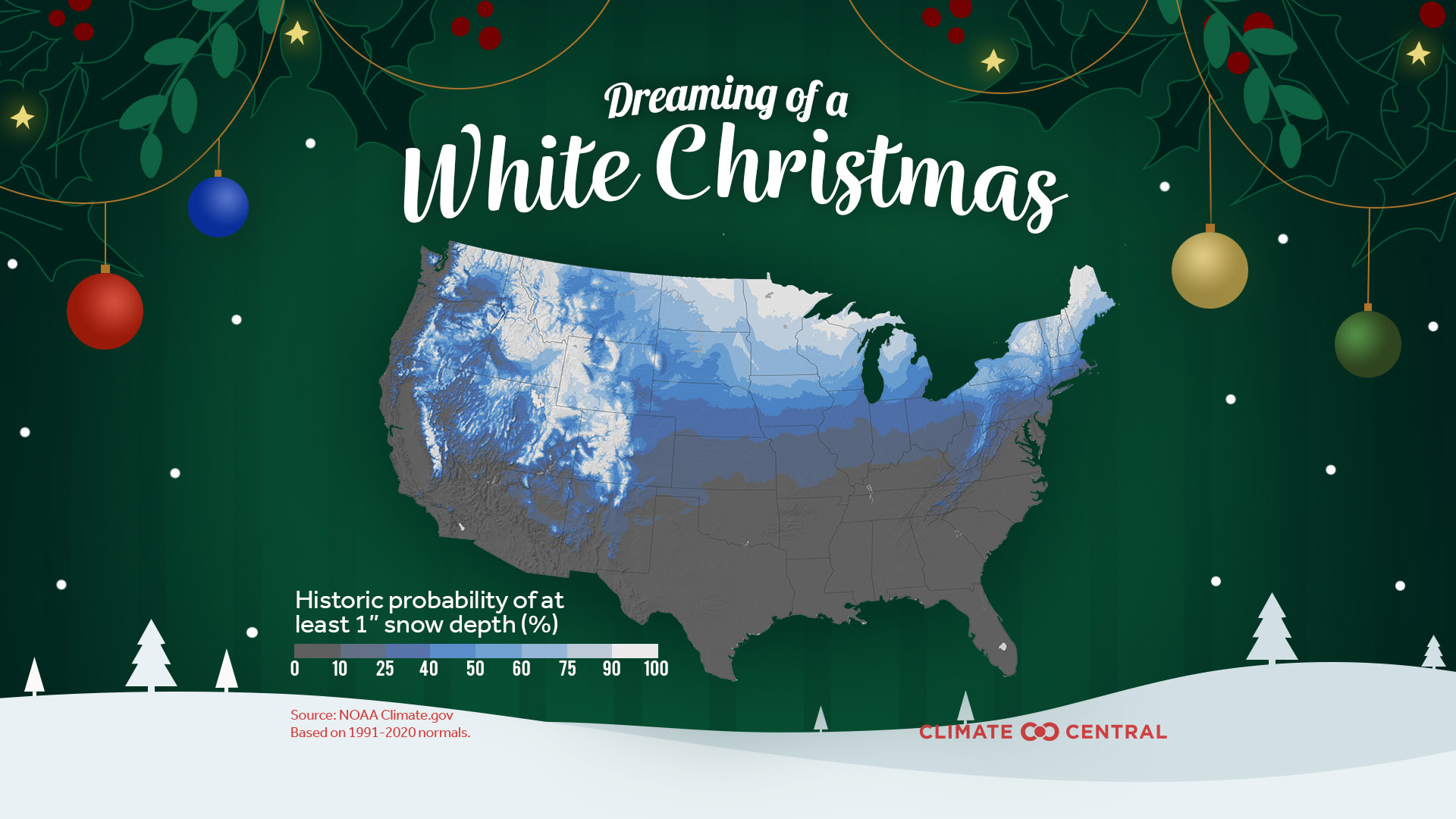KEY CONCEPTS
The Twelve Days of Christmas (December 25 to January 5) have been warming for 97% of locations evaluated since 1969.
With a warmer climate, it is likely that more winter precipitation will fall as rain rather than snow in many parts of the country.
Still dreaming of a white Christmas? NOAA’s new interactive map shows the historical probability of a white Christmas in your area based on 1991-2020 U.S. Climate Normals.
Climate change threatens symbols of the holiday season, from Christmas tree growth, winter recreation, and cozy drinks to Arctic wildlife.
The Twelve Days of Christmas (December 25 to January 5) have been warming since 1969. Using temperature data at 246 locations across the country, our analysis shows:
97% of stations have seen an increase in average temperature for this 12-day period since 1969.
Warming has exceeded 1°F for 94% of locations, 3°F for 75% of locations, and 5°F for 37% of locations.
Temperatures have climbed from coast to coast. The locations that have warmed the most are: Reno, Nev. (9.5°F); Burlington, Vt. (9.1°F), Milwaukee, Wisc. (8.6°F), Helena, Mont. (8.5°F), and Waterloo, Iowa (8.4°F).
If you’re dreaming of a white Christmas… your chances are best in Idaho, Minnesota, Maine, Upstate New York, and the Allegheny, Rocky, or Sierra Nevada Mountains.
The historical probability of a white Christmas (at least 1 inch of snow accumulation on December 25) is slimmer for the rest of the contiguous U.S. based on NOAA’s analysis of the most recent climate normals (1991-2020).
Winter has been the fastest-warming season for most of the U.S. since 1970, increasing the likelihood of winter precipitation falling as rain rather than snow.
Warmer winters are disrupting the water cycle in the western U.S., which relies on mountain snowpack for much of its freshwater supply. Decades of shrinking snowpack has reduced snow-derived freshwater in the west by 15-30% since 1955.
Rockin’ around the… plastic tree? A warming winter season puts holiday traditions at stake.
Christmas trees feeling the heat: Wildfires and a record-breaking heatwave in June 2021 scorched Christmas tree farms in the Pacific Northwest. This potentially impacts tree supplies and prices this year and into the future as heat-stunted seedlings mature.
Winter recreation meltdown: Activities like skiing, skating, ice fishing, and snowman-building are threatened by a rising number of above-freezing days.
Festive food and drink: Maple syrup, cocoa for hot chocolate, apples for pie and cider, and brandy for eggnog are all climate-sensitive. Warmer, shorter winters can disrupt growth and production timelines, or shift them poleward altogether.
Life in the North Pole:Waning sea ice coverage, changing temperature and precipitation trends, and shifting vegetation are transforming Arctic ecosystems including icons of the holiday season such as polar bears and reindeer.
POTENTIAL LOCAL STORY ANGLES
Will you be having a white Christmas this season?
NOAA’s interactive map provides a guide to the historical probability of a white Christmas near you based on the last 30 years of weather data. Check your local forecast within a week of Christmas for the actual weather conditions up on your rooftop this year.
How are Christmas trees doing near you?
Nearby tree farms can be found using the National Christmas Tree Association’s Tree Locator. Local guidelines on disposing of Christmas trees and holiday lights are posted at PickYourOwnChristmasTree.org. Figure out whether you should opt for a real or fake tree based on local availability, expected lifespan, and what you plan to do with the tree once the holidays are over.
How can you have a more climate-friendly holiday?
Consider giving locally-sourced, secondhand, or experience-based gifts this holiday season. Reduce waste by sending and requesting gift wishlists. Many coated wrapping papers aren’t recyclable, so get creative with repurposed items or forego gift wrapping altogether. LED and timed holiday lighting can help cut energy use.
LOCAL EXPERTS
The SciLine service, 500 Women Scientists or the press offices of local universities may be able to connect you with local scientists who have expertise on CHANGE and climate change. The American Association of State Climatologists is a professional scientific organization composed of all 50 state climatologists.
NATIONAL EXPERTS
Elizabeth Burakowski, PhD
Research Assistant Professor
University of New Hampshire
Contact: Elizabeth.Burakowski@unh.edu
METHODOLOGY
Average temperatures were calculated for the period from December 25 - January 5 for 1969-70 to 2020-21 using data obtained from the Applied Climate Information System. Climate Central's local analyses include 247 stations. However, for data summaries based on linear trends, only 246 stations are included due to large data gaps in Wheeling, W.Va.
